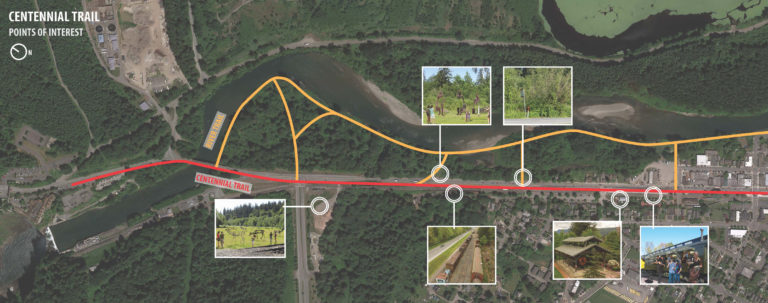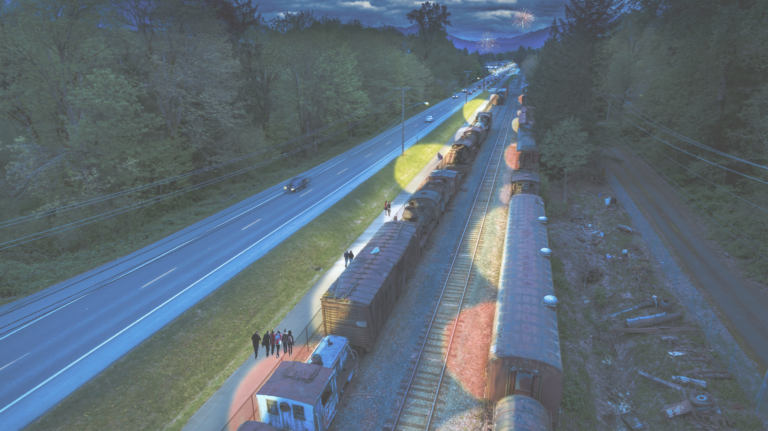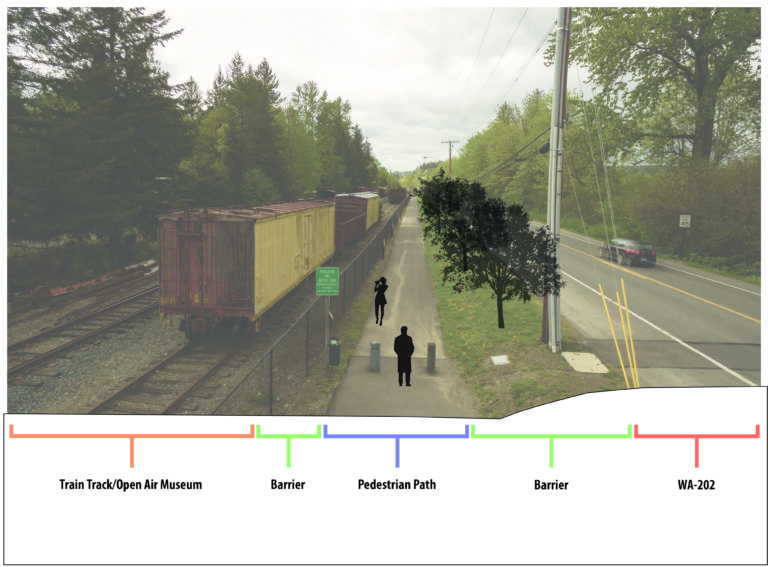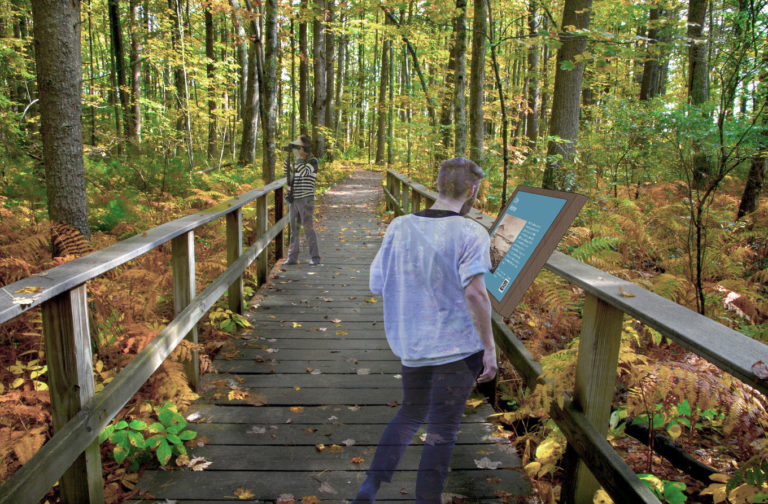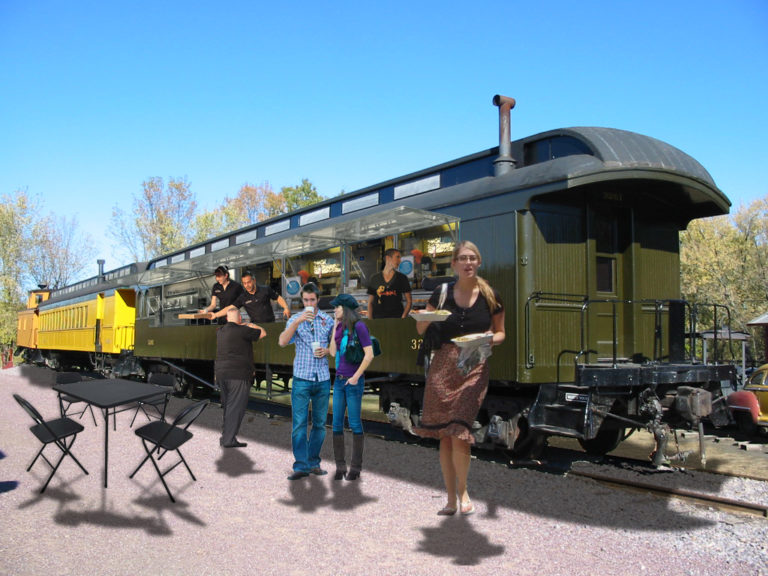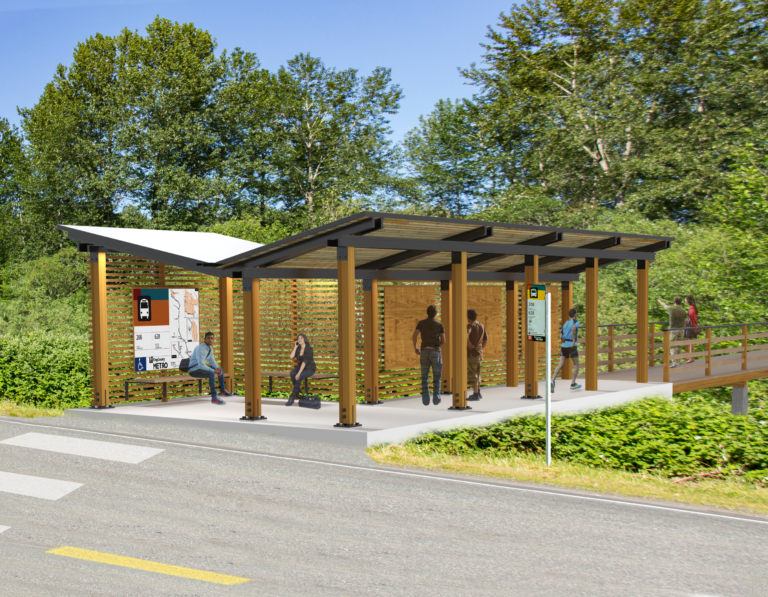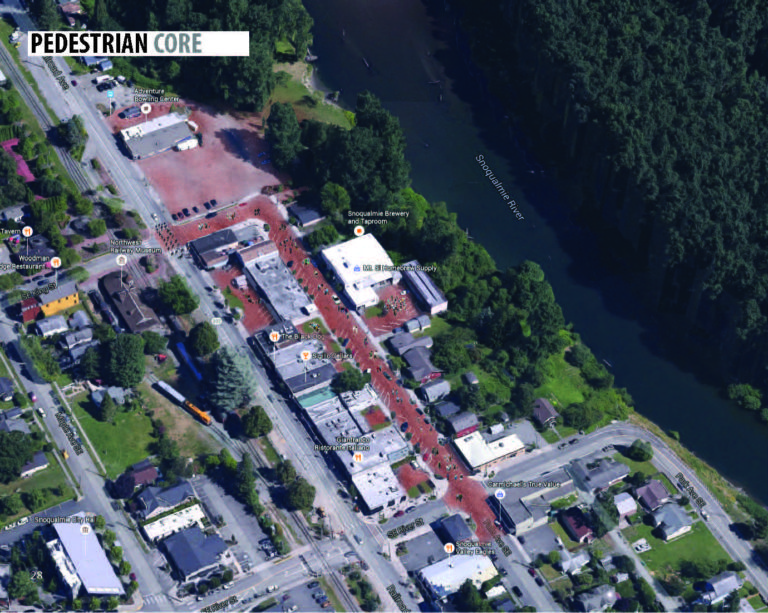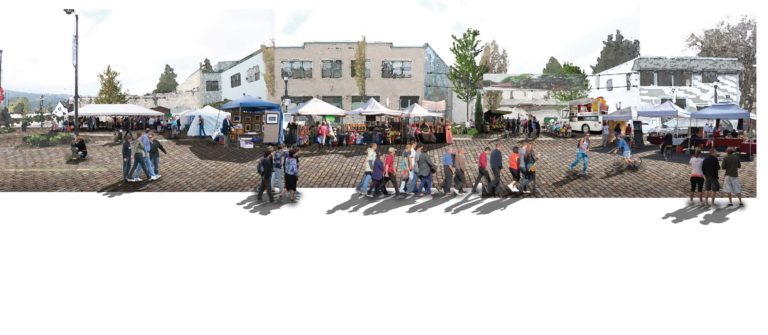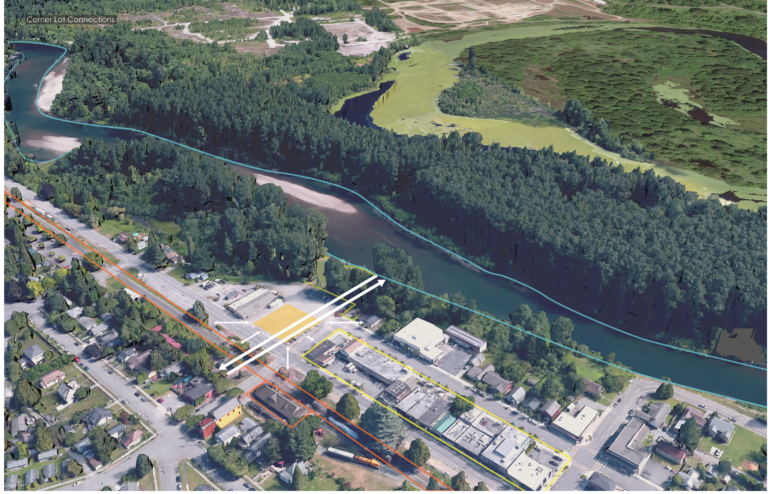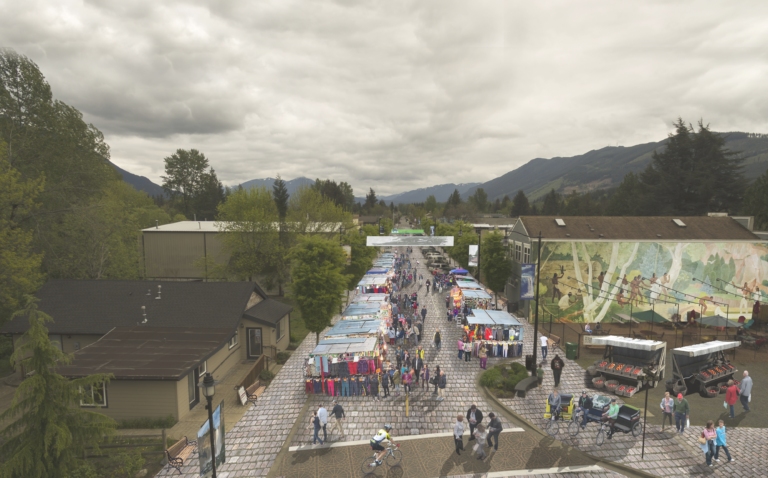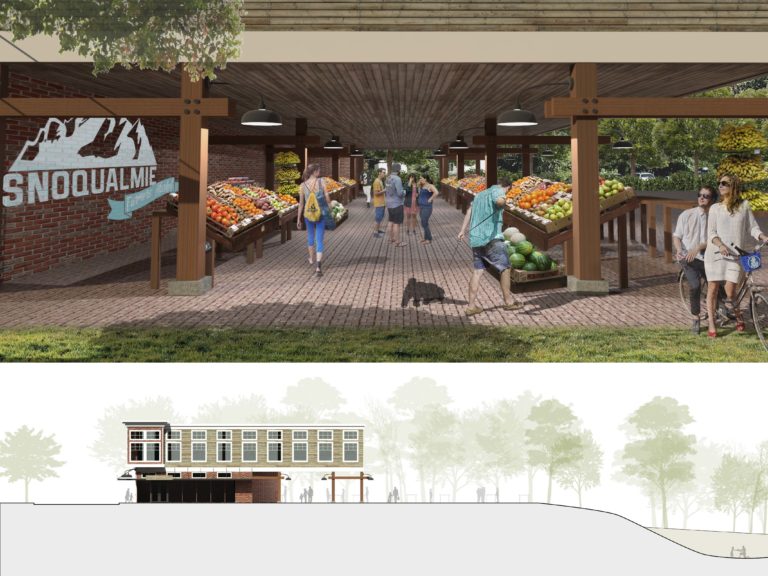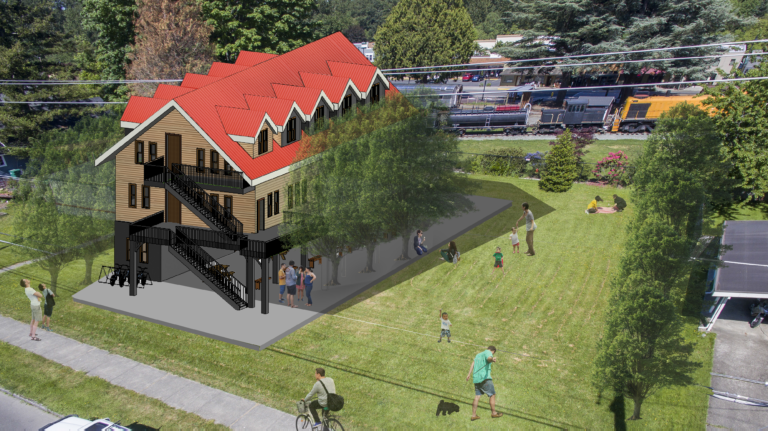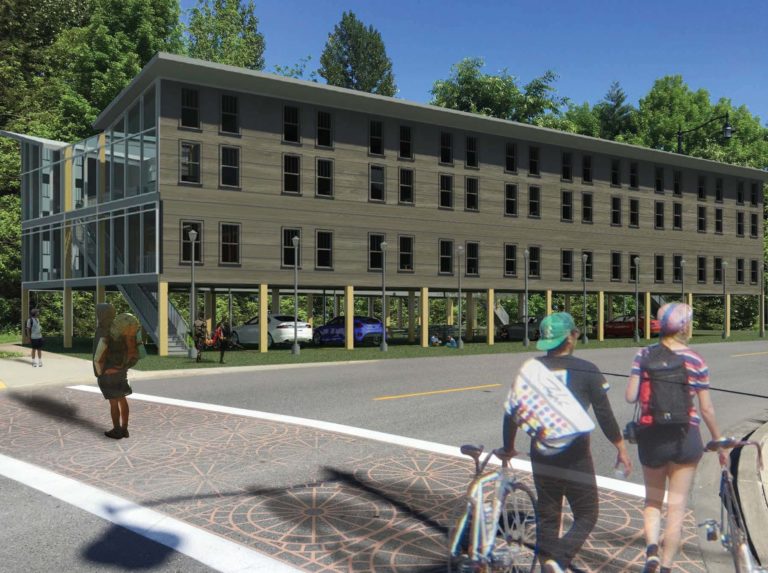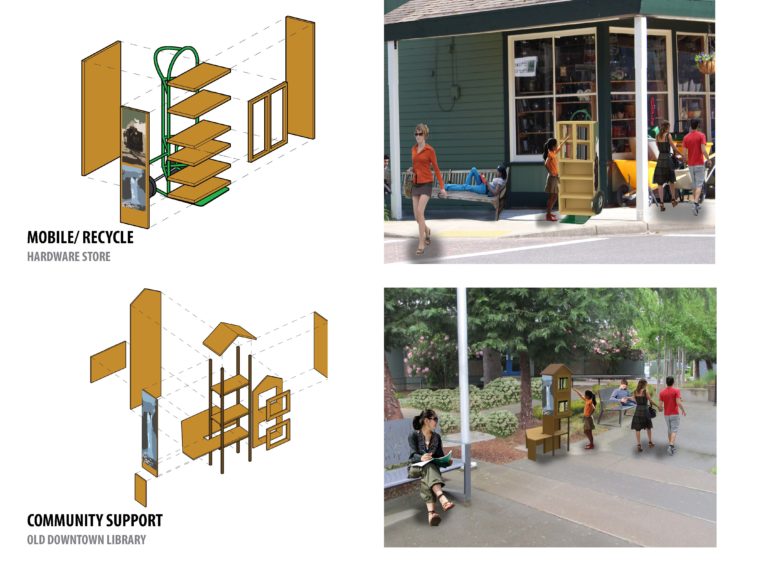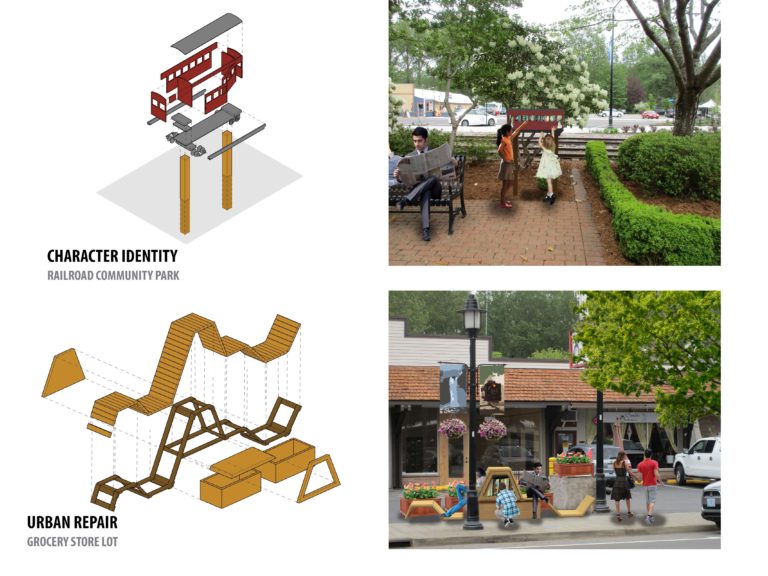In partnership with King County Historic Preservation, the City of Snoqualmie Community Development, the Storefront Studio developed a set of enhancement strategies for the Historic Main Street area. Vetted and revised, these designs are a mix of community-generated projects demonstrating resilience, inclusivity and authenticity.
 (1/16) The Salish Lodge at Snoqualmie Falls brings thousands of visitors to the area each year, but visitors do not often find their way into the historic downtown due to poor pedestrian connections. Linking points of interest, through refurbishing existing artifacts and adding new attractions, would improve the existing Centennial Trail, drawing visitors from the lodge to the historic downtown through an open air museum.
(1/16) The Salish Lodge at Snoqualmie Falls brings thousands of visitors to the area each year, but visitors do not often find their way into the historic downtown due to poor pedestrian connections. Linking points of interest, through refurbishing existing artifacts and adding new attractions, would improve the existing Centennial Trail, drawing visitors from the lodge to the historic downtown through an open air museum. Many Snoqualmie residents view the train artifacts as an asset to the community. City support exists for improvements along the railroad for an more active viewing experience of the train artifacts.
Many Snoqualmie residents view the train artifacts as an asset to the community. City support exists for improvements along the railroad for an more active viewing experience of the train artifacts. The Snoqualmie Centennial Trail runs alongside busy SR-202, which can be distracting and dangerous. At points along the trail, the roadway is higher than the head of a pedestrian walking down the pathway. Adding a barrier like trees, stone walls, or bollards between road and path would create a more comfortable, safer space on the path while still engaging passing vehicles with the trail.
The Snoqualmie Centennial Trail runs alongside busy SR-202, which can be distracting and dangerous. At points along the trail, the roadway is higher than the head of a pedestrian walking down the pathway. Adding a barrier like trees, stone walls, or bollards between road and path would create a more comfortable, safer space on the path while still engaging passing vehicles with the trail. In order to reduce the environmental impact along the river, the walkway is elevated to prevent users from venturing off the designated walkway and to protect the infrastructure during flooding.
In order to reduce the environmental impact along the river, the walkway is elevated to prevent users from venturing off the designated walkway and to protect the infrastructure during flooding. The Centennial Log, housed under an old building in Railroad Community Park, is an example of the logs once plentiful in the Snoqualmie region prior to logging. It’s hard to imagine how tall these giants were, with heights reaching up to 300 feet. We propose two installations for the Centennial Log: a timeline on the log showing the tree's width relative to historic events, and a stenciled graphic on the Centennial Trail marking certain tree heights compared to a common object.
The Centennial Log, housed under an old building in Railroad Community Park, is an example of the logs once plentiful in the Snoqualmie region prior to logging. It’s hard to imagine how tall these giants were, with heights reaching up to 300 feet. We propose two installations for the Centennial Log: a timeline on the log showing the tree's width relative to historic events, and a stenciled graphic on the Centennial Trail marking certain tree heights compared to a common object. A café, set between the centennial log and train artifacts and housed in a existing train car, would provide tourists with food, drinks, and a place to stop along the Snoqualmie Trail.
A café, set between the centennial log and train artifacts and housed in a existing train car, would provide tourists with food, drinks, and a place to stop along the Snoqualmie Trail. The bus stop at the intersection of SE Northern St and Railroad Ave SE will get busier as more people visit Snoqualmie. A new structure would provide people with safe, covered seating along Railroad Ave.
The bus stop at the intersection of SE Northern St and Railroad Ave SE will get busier as more people visit Snoqualmie. A new structure would provide people with safe, covered seating along Railroad Ave. Falls Avenue, from the bowling alley to the hardware store, is envisioned as a mix of pedestrian and cars. The purpose of this muse is to connect the primary forces of the city with the naturally occurring secondary flows. Active public spaces bring pedestrians from Railroad Avenue (the front porch) to Falls Avenue (the back porch).
Falls Avenue, from the bowling alley to the hardware store, is envisioned as a mix of pedestrian and cars. The purpose of this muse is to connect the primary forces of the city with the naturally occurring secondary flows. Active public spaces bring pedestrians from Railroad Avenue (the front porch) to Falls Avenue (the back porch). A range of permanent and temporary active public spaces, include a comfortable bench, sidewalk dining, a street market, stormwater raingardens and bioswales.
A range of permanent and temporary active public spaces, include a comfortable bench, sidewalk dining, a street market, stormwater raingardens and bioswales. The corner lot at Railroad Ave and NE King St is a crucial link between the residential area of downtown, the train station, the main street, and the river.
The corner lot at Railroad Ave and NE King St is a crucial link between the residential area of downtown, the train station, the main street, and the river. The corner lot could be utilized as an inclusive community center that serves the people of Snoqualmie and facilitates connections. It would be a flexible space to hold events – both indoor and outdoor – such as farmers markets, community movie nights, birthday parties, and could be a special space to gather during festivals.
The corner lot could be utilized as an inclusive community center that serves the people of Snoqualmie and facilitates connections. It would be a flexible space to hold events – both indoor and outdoor – such as farmers markets, community movie nights, birthday parties, and could be a special space to gather during festivals. Snoqualmie has significant tourist attractions including the Snoqualmie Falls and Train Depot. There is currently only one place to stay overnight, the Salish Lodge. To provide a diversity of options for lodging, two different building designs support a range of accommodation types, each with an additional civic role.
Snoqualmie has significant tourist attractions including the Snoqualmie Falls and Train Depot. There is currently only one place to stay overnight, the Salish Lodge. To provide a diversity of options for lodging, two different building designs support a range of accommodation types, each with an additional civic role. Snoqualmie has significant tourist attractions including the Snoqualmie Falls and Train Depot. There is currently only one place to stay overnight, the Salish Lodge. To provide a diversity of options for lodging, two different building designs support a range of accommodation types, each with an additional civic role.
Snoqualmie has significant tourist attractions including the Snoqualmie Falls and Train Depot. There is currently only one place to stay overnight, the Salish Lodge. To provide a diversity of options for lodging, two different building designs support a range of accommodation types, each with an additional civic role. One is a lodge with an adjacent park and the other is a motel providing access to the waterfront. Both are raised up one story to provide open ground floors for community access and amenity, as well as, addressing flood-zone constraints.
One is a lodge with an adjacent park and the other is a motel providing access to the waterfront. Both are raised up one story to provide open ground floors for community access and amenity, as well as, addressing flood-zone constraints. The mobile Little Library is a low cost, easily maneuverable option requiring little skill and time and utilizes Recycled components.The little park between town hall and the Old Library is the perfect location to insert a Little Free Library, and could benefit the local boy scouts a major user group within this building. A small bench and shelf are integrated into the design, allowing someone visiting the library to briefly sit while checking out a book.
The mobile Little Library is a low cost, easily maneuverable option requiring little skill and time and utilizes Recycled components.The little park between town hall and the Old Library is the perfect location to insert a Little Free Library, and could benefit the local boy scouts a major user group within this building. A small bench and shelf are integrated into the design, allowing someone visiting the library to briefly sit while checking out a book. Given its close proximity to the rails and the museum, the Character Identity Little Library at the Railroad Community Park would be modeled after a toy train, reminding visitors of the rich railway history all around them. By taking the space of an adjacent parking spot, the urban bench-style repair little library library could change the lot into a place to relax and enjoy. Storage space under the bench could house non-perishable food donation.
Given its close proximity to the rails and the museum, the Character Identity Little Library at the Railroad Community Park would be modeled after a toy train, reminding visitors of the rich railway history all around them. By taking the space of an adjacent parking spot, the urban bench-style repair little library library could change the lot into a place to relax and enjoy. Storage space under the bench could house non-perishable food donation.
